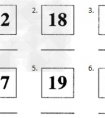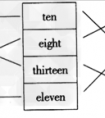选择正确的序数词或基数词填空。There are (twelve) books on the bookcase. The (eight) book is about animals.-六年级英语
为了简便起见,月份与日期连用时,月份常用缩写形式表示。
缩写形式除May,June,July外,其它的月份都由其前三个字母表示,但September除外。
January——Jan.一月
February——Feb.二月
March——Mar. 三月
April——Apr.四月
August——Aug.八月
September——Sept.九月
October——Oct.十月
November——Nov.十一月
December——Dec.十二月
注:这里缩写形式后面加点不能省略,因为它是表示缩写形式的符号。
C.日期用定冠词the加序数词表示。在哪一天要添加介词on。
National Day is on Oct. 1.
国庆节是十月一日。(读作 October first)
此句也可以表示为 National Day is on the 1st of October.
May 5 五月五日(读作May fifth)
也可以表示为the fifth(5th)of May
Mar. 1(st) 三月一日(读作March first或 the first of March)
5. 表示不具体、不确切的时间,如世纪、年代、年份、月份时,用介词in表示;
表示具体确切的某一天用介词on表示通常情况下morning,afternoon,evening等词前用介词in。
但是,当这些词前后有一修饰限定的词作为定语,把它们限定为某一天早晨、下午或晚上时,介词in应改为on。
这里的修饰限定词可以是介词短语、名词、形容词、定语从句等。
On a cold morning,the old man died lonely in his house.
在一个寒冷的早晨,这个老人孤独地死在自己的房子里。
I don/’t want to be disturbed on nights when I have to study.
我不愿意在我必须学习的晚上被打扰。
The accident happened on the afternoon of July 7.
这次事故发生在7月7日下午。
We are to have a small test on Monday morning.
星期一早晨我们将进行一次小测验。
四、加减乘除表示法
1. “加”用plus,and或add表示;“等于”用is,make,equal等词表示。
2+3=? 可表示为: How much is two plus three?
2+3=5
Two plus three is five.
Two and three is equal to five.
Two and three make five.
Two added to three equals five.
If we add two to/and three, we get five.
二加三等于五
2. “减”用 minus或 take from表示
10-6=? How much is ten minus six?
10-6=4
Ten minus six is four.
Take six from ten and the remainder is four.
Six (taken) from ten is four.
十减去六等于四
3. “乘”用time(动词)或multiply表示
3×4=? How much is three times four?
3×4=12
Three times four is/are twelve.
Multiply three by four,we get twelve.
Three multiplied by four makes twelve.
三乘以四等于十二
4. “除”用divide的过去分词形式表示
16÷4=? How much is sixteen divided by four?
16÷4=4
Sixteen divided by four is four.
Sixteen divided by four equals/gives/makes four.
十六除以四等于四。
考点名称:序数词
- 序数词:
即表示顺序的数词。
A、1-3的序数词。 第1 first 第2 second 第3 third
B、4-19的序数词的表示方法,是由“基数词+ th”构成。
如:第4 fourth 第5 fifth 第8 eighth 第18eighteenth
C、20-100的序数词的表示方法。
a. 整数的表示方法,是把整数基数词的词尾“y”改写成“i”,然后加-eth,如:第20 twentieth 30 thirtieth
b. “百”的序数词的表示方法是在hundred词尾直接加“-th”如:第100 a hundredth
c. 其他两位数序数词的表示方法:由基数词变化而来,十位数不变,个位数上的基数词变成序数词,中间用连字符“-”连接。如:第21 twenty-first 第52 fifty-second - 序数词的缩写:
有时,序数词可以用缩写形式来表示。主要缩写形式有。
first—lst
second—2nd
third—3rd
fourth—4th
sixth—6th
twentieth—20th
twenty-third——23rd
其中lst,2nd,3rd为特殊形式,其它的都是阿拉伯数字后加上th。 - 基数词变序数词方法口诀:
口诀 解说 举例 基变序,有规律,后边th加上去 在数词后面加th。 four→fourth 一二三,特殊记,后面字母t,d,d。 one,two,three特殊变。 first,second,third 八去t,九去e。整数中的y要变成ie eight去掉t,nine去掉e。twenty去掉y变成twentieth eight→eighthnine→ninth f来把ve替。 five和twelve的ve要变成f。 five→fifthtwelve→twelfth 若是遇到几十几,只变个位就可以。 两位数或两位以上数字只变个位。 thirty-three→thirty-third 序数词前要加the我们一定要牢记。 序数词前必须加the(上述原则中的除外) thefirstday 序数词表示法:
一、分数表示法
1. 分数是由基数词和序数词一起来表示的。基数词作分子,序数词作分母,除了分子是“1”以外,其它情况下序数词都要用复数形式。
3/4 three fourths或 three quarters
1/3 one third或a third
24/25 twenty-four twenty-fifths
3又1/4 three and one fourth或 three and one quarter
1/2 a half
1/4 one quarter或a quarter
1又1/2 one and a half
1又1/4 one and a quarter
2. 当分数后面接名词时,如果分数表示的值大于1,名词用复数;小于1,名词用单数。
1又1/2 hours 一个半小时(读作 one and a half hours)
2又3/4 meters 二又四分之三米(读作two and three-fourths meters)
4/5 meter 五分之四米
5/6 inch 六分之五英寸
3. 表示“n次方”的说法:指数用序数词,底数用基数词。
10的7次方 the seventh power of ten(ten to the seventh power)
6的10次方 the tenth power of six(six to the tenth power)二、百分数表示法
百分数用基数+percent表示
50% fifty percent 百分之五十
3% three percent 百分之三
0.12% zero point one two percent 百分之零点一二
这里的percent前半部per表示“每一”,cent这一后半部分表示“百”,所以百分之几中percent不用复数形式。三、数量表示法
1. 表示长、宽、高、面积等,用基数词+单位词(meter,foot,inch,kilogram等)+ 形容词(long,wide,high等)表示,或者用基数词+单位词 + in + 名词(length, width, height, weight等)表示。
two meters long或 two meters in length 2米长
three feet high或 three feet in height 3英尺高
four inches wide或 four inches in width 4英寸宽
This box is 2 kilograms in weight.
这个盒子有两千克重。
The city wall of Xi/’an is 12 meters wide and 12 meters high.
西安城墙是12米宽,12米高。
2. 表示时间、距离时,使用含数词的名词所有格形式作定语。
five minutes/’ walk
步行五分钟(的距离)
It/’s an hour/’s ride from my hometown to our university.
从我的家乡到我们大学是乘车一小时的路程。
或:从我的家乡到我们大学需要乘车一小时。
It/’s three kilometers/’ distance from our campus to the Bell Tower.
从我们校园到钟楼有三公里远。
3. 表示温度时,用below zero表示零下温度,温度用基数词+degree(s)+单位词(centigrade摄氏或Fahrenheit华氏)表示。
thirty-six degrees centigrade或 36℃ 摄氏 36度
four degrees below zero centigrade或 -4℃ 摄氏零下4度
Water freezes at thirty-two degrees Fahrenheit.
水在华氏三十二度时结冰。
Water boils at one hundred degrees centigrade.
水在摄氏一百度时沸腾。
这里的单位词在人们都很清楚是什么度量制度时,可以省略。
You are 37℃.(读作 thirty-seven degrees)
你是三十七度。(摄氏)
It/’s seven degrees below zero.
今天是零下七度。(摄氏)
4. 由数词和其他名词构成的名词性短语作定语时,其中的名词用单数形式,名词性短语中各部分间要用连字符“-”来连接。
It/’s a five-minute walk from the library to the playground.
从图书馆到操场需要走五分钟。
She/’s a sixteen-year-old girl.
她是个十六岁的女孩。
5. 表示“比···大(或)几倍”的说法。
This room is two times bigger than that one.
这个房间比那个(房间)大两倍。
The dictionary is four times thicker than that book.
这本词典比那本书厚四倍。
My age is two times older than his.
- 最新内容
- 相关内容
- 网友推荐
- 图文推荐
| [家长教育] 孩子为什么会和父母感情疏离? (2019-07-14) |
| [教师分享] 给远方姐姐的一封信 (2018-11-07) |
| [教师分享] 伸缩门 (2018-11-07) |
| [教师分享] 回家乡 (2018-11-07) |
| [教师分享] 是风味也是人间 (2018-11-07) |
| [教师分享] 一句格言的启示 (2018-11-07) |
| [教师分享] 无规矩不成方圆 (2018-11-07) |
| [教师分享] 第十届全国教育名家论坛有感(二) (2018-11-07) |
| [教师分享] 贪玩的小狗 (2018-11-07) |
| [教师分享] 未命名文章 (2018-11-07) |


![Hello! You can see ___________crayons. [ ]A. threeB. fourC. five-三年级英语](http://www.00-edu.com/d/file/ks/4/1/15/2019-08-13/small07da1502b58cf7152f184ff6e541c84b1565709386.jpg)



